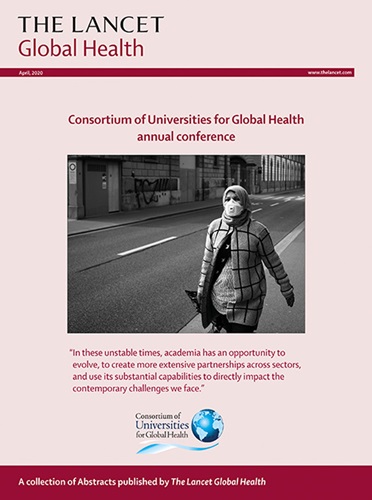扩大母乳喂养对减轻全球母亲和儿童非传染性疾病负担的影响:对132个低收入和中等收入国家的基于人口的建模分析。
IF 19.9
1区 医学
Q1 PUBLIC, ENVIRONMENTAL & OCCUPATIONAL HEALTH
引用次数: 0
摘要
越来越多的证据表明,母乳喂养对母亲及其后代在以后的生活中预防非传染性疾病(NCDs)具有长期保护作用。这些好处在人口层面上可能是巨大的,但尚未得到严格的量化。我们的目的是在132个低收入和中等收入国家(LMICs)估计扩大纯母乳喂养对母亲及其后代长期非传染性疾病负担的人口水平影响。方法在这个基于人口的建模分析中,我们基于人口影响分数估计值,利用现有的影响估计值和全球输入数据,开发了数学模拟模型。我们进行了总体评价,以获得高质量荟萃分析的综合效应估计,并使用AMSTAR-2评估质量。输入数据包括特定原因死亡率(全球疾病、伤害和风险因素负担研究)、糖尿病和高血压患病率(非传染性疾病风险因素合作)、基线纯母乳喂养覆盖率(世卫组织-联合国儿童基金会)和人口统计数据(联合国人口司)。我们量化了四种纯母乳喂养覆盖情景下的延迟原因特异性非传染性疾病死亡、避免的糖尿病和高血压病例以及获得的生命年数(YLG)。所有未来福利都折现(3%)。在132个中低收入国家,将纯母乳喂养覆盖率扩大到90%,可在两代人中延迟0.17%的非传染性疾病死亡,相当于每年延迟7.23万例非传染性疾病死亡,产生10.4万元gdp。它使2型糖尿病的患病率大幅降低了1.29%(在队列的整个生命周期中避免了1000万例病例),中度降低了高血压的患病率0.17%(避免了380万例病例)。产妇占延迟死亡的42%,占避免糖尿病病例的23%,约占总死亡人数的一半。从区域来看,东南亚、东亚和大洋洲,其次是南亚,由于人口规模的原因,绝对收益最大;然而,在对队列和人口规模进行调整后,撒哈拉以南非洲、北非和中东地区每百万被干预的母亲中获益最大。大多数延迟死亡是缺血性心脏病(43%)和中风(33%),癌症占18%。扩大纯母乳喂养覆盖率可带来减少非传染性疾病的益处,并补充其对儿童死亡率和儿童早期发展的既定益处。FUNDINGNutrition国际。本文章由计算机程序翻译,如有差异,请以英文原文为准。
Impact of scaling up breastfeeding on reducing the global burden of non-communicable diseases in mothers and children: a population-based modelling analysis for 132 low-income and middle-income countries.
BACKGROUND
Growing evidence suggests breastfeeding offers long-term protective effects against non-communicable diseases (NCDs) later in life in mothers and their offspring. These benefits could be substantial at the population level but have not yet been rigorously quantified. We aimed to estimate the population-level effect of scaling up exclusive breastfeeding on long-term NCD burden in mothers and their offspring in 132 low-income and middle-income countries (LMICs).
METHODS
In this population-based modelling analysis, we developed mathematical simulation models based on the population impact fraction estimator and leveraging available effect estimates and global input data. We conducted umbrella reviews to obtain pooled effect estimates from high-quality meta-analyses, with quality assessed using AMSTAR-2. Input data included cause-specific mortality (Global Burden of Diseases, Injuries, and Risk Factors Study), diabetes and hypertension prevalence (NCD Risk Factor Collaboration), baseline exclusive breastfeeding coverage (WHO-UNICEF), and demographics (UN Population Division). We quantified delayed cause-specific NCD deaths, averted diabetes and hypertension cases, and years of life gained (YLG) across four exclusive breastfeeding coverage scenarios. All future benefits were discounted (3% rate).
FINDINGS
Scaling up exclusive breastfeeding coverage to 90% in 132 LMICs could delay 0·17% of NCD deaths across the two generations, equivalent to 72 300 delayed NCD deaths annually, yielding 1·04 million YLG. It substantially reduced type 2 diabetes prevalence by 1·29% (10 million cases averted across the lifespan of the cohort) and moderately reduced hypertension prevalence by 0·17% (3·8 million averted cases). The maternal generation constituted 42% of delayed deaths, 23% of averted diabetes cases, and approximately half of the total YLG. Regionally, southeast Asia, east Asia, and Oceania followed by south Asia had the largest absolute benefits due to population size; however, after adjusting for cohort and population size, sub-Saharan Africa and north Africa and the Middle East showed the largest benefits per million intervened mothers. Most delayed deaths were from ischaemic heart disease (43%) and stroke (33%), with cancer accounting for 18%.
INTERPRETATION
Scaling up exclusive breastfeeding coverage could lead to benefits in reducing NCDs, complementing its established benefits for child mortality and early childhood development.
FUNDING
Nutrition International.
求助全文
通过发布文献求助,成功后即可免费获取论文全文。
去求助
来源期刊

Lancet Global Health
PUBLIC, ENVIRONMENTAL & OCCUPATIONAL HEALTH-
CiteScore
44.10
自引率
1.20%
发文量
763
审稿时长
10 weeks
期刊介绍:
The Lancet Global Health is an online publication that releases monthly open access (subscription-free) issues.Each issue includes original research, commentary, and correspondence.In addition to this, the publication also provides regular blog posts.
The main focus of The Lancet Global Health is on disadvantaged populations, which can include both entire economic regions and marginalized groups within prosperous nations.The publication prefers to cover topics related to reproductive, maternal, neonatal, child, and adolescent health; infectious diseases (including neglected tropical diseases); non-communicable diseases; mental health; the global health workforce; health systems; surgery; and health policy.
 求助内容:
求助内容: 应助结果提醒方式:
应助结果提醒方式:


